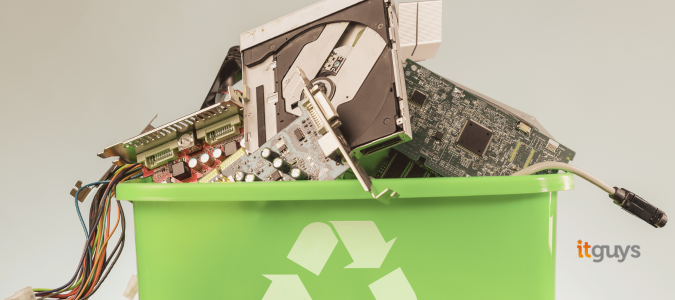The State we're in
Since 2010, there has been a significant increase in both the number of internet users and global internet traffic. The global IT carbon footprint is multifaceted, including emissions from manufacturing, operation, and disposal of equipment. Although estimates vary, a consensus suggests that IT is responsible for 1.8% to 3.9% of global emissions, with Professor Mike Berners-Lee’s 2020 estimate placing it at 2.5%. This carbon footprint is roughly divided equally between user devices, TVs and entertainment systems, and data centres, networks, and cryptocurrencies, with the majority of emissions for user devices occurring during manufacture.
The future trajectory of IT’s carbon footprint remains uncertain due to rapid technological changes and emerging innovations such as AI, IoT, and blockchain. While there are promising trends towards improved energy efficiency and commitments from key industry players towards net-zero goals, the sector’s growth poses a challenge. The reduction of its carbon footprint depends on proactive steps from the industry and potential government regulations.
Data centres and networks are substantial electricity users, contributing to around 0.9% of energy-related greenhouse gas emissions. Despite the surge in demand for digital services, emissions have grown only modestly since 2010 thanks to better energy efficiency in hardware and a shift towards more efficient cloud and hyperscale data centres. Mobile networks, which consume the majority of network energy, have also seen significant efficiency improvements. However, further efforts are essential in energy efficiency, renewable procurement, and R&D to manage future demand and emissions.
Global trends from 2015 to 2022 show a 78% increase in internet users and a 600% rise in internet traffic. Data centre energy use has increased by 20-70%, excluding cryptocurrency mining, which has skyrocketed by 2300-3500%. Network energy use has also risen by 18-64%. These increases highlight the need for continued focus on energy efficiency and the potential impact of growing traffic from various services and technologies.
In terms of renewable energy, IT companies are significant investors, particularly hyperscale data centre operators. Although renewable energy use is complicated for distributed systems such as data transmission networks, these investments are driven by reasons such as mitigating power price volatility and enhancing brand reputation. However, claims by tech giants of matching 100% of their electricity use with renewable sources are somewhat misleading, as this often involves purchasing renewable energy certificates, which does not guarantee additional renewable
production or direct emissions reductions. (If everyone buys carbon credits to “offset”, does the amount of carbon release into the atmosphere go down?)
What this means in laypersons terms
Some key facts
| A single short email | 0.2 to 0.3g CO2e |
| A longer email, or an emailcopied into several people | 17g to 26g CO2e |
| A person's average yearly email traffic | 3kg CO2e |
| A simple google search | 0.5g CO2e |
| 5 minutes web browsing | 5.6g to 8.2g CO2e |
Email is not a big deal in terms of saving carbon. A person’s average yearly email traffic is equivalent to driving 13 miles in a small petrol car.
Half an hour of browsing the web has around the same carbon footprint as boiling a kettle.
The biggest part of the carbon footprint for both of these is the embodied carbon in the user’s device.
The carbon footprint of a computer
A new laptop has an embodied carbon footprint of between 326kg CO2e and 620kg CO2e. The bigger the physical size of the laptop, the bigger the footprint, in general. This is high, due to the raw materials and high-tech processes involved in making them.
A new laptop has the footprint of a flight from London to Rome, but its use is pretty low-carbon, at up to 10g CO2e per hour. That goes up to 50g CO2e per hour for a desktop computer with screen. The way to get better carbon value from a computer is to get many years of life from it.
Similarly, the main part of the footprint of a video call is the embodied emissions of the hardware. The actual call’s impact is pretty minimal. But the emissions you avoid can be of a whole different order. For example, you could save 20 tonnes CO2e by videoconferencing rather than two people flying from Europe for a meeting in Hong Kong. That is equivalent to taking 11 cars off the road.
What the earth needs
The pressing need to mitigate the IT sector’s carbon footprint cannot be overstated. With the sector accounting for an estimated 2.5% of global emissions, the importance of reducing carbon release into the atmosphere is critical in combating climate change and its devastating effects. If global temperatures rise beyond the threshold of 2 degrees Celsius, we risk triggering catastrophic environmental consequences: severe weather events, loss of ecosystems, and a crisis for food and water sources, all of which threaten the very fabric of our society and the stability of economies worldwide.
Our duty of care to future generations mandates immediate action. We have the responsibility to ensure that the planet we pass on is habitable and that the resources we take for granted today are preserved for tomorrow. The IT sector, therefore, must lead by example, not only because it is a significant contributor to global emissions but also because of its innovative capacity to drive change across all sectors of the economy.
Reducing the carbon footprint of IT, particularly from user devices, entertainment systems, data centres, networks, and the burgeoning field of cryptocurrencies, requires a concerted effort. This involves enhancing energy efficiency, shifting towards more sustainable cloud and hyperscale data centres, and investing in renewable energy sources. It is not enough for companies to claim renewable energy usage through certificates; there must be a tangible and direct reduction in emissions.
We are at a defining moment. The choices made by the IT sector today will resonate for generations. It’s our collective responsibility to ensure that as we advance technologically, we do not do so at the expense of our planet’s health. Acting now to reduce carbon output is not just an environmental imperative but a moral one, ensuring a safe, sustainable, and equitable world for the future.
How to practically reduce carbon
There are practical steps both companies and individuals can undertake to reduce their carbon emissions, which is essential for a sustainable future. Companies can implement policies that extend the lifecycle of devices by encouraging repairs rather than replacements and can incentivise the return and recycling of old equipment. They can also adopt cloud computing solutions that are more energy-efficient than traditional on-site data centres and opt for green hosting providers that use renewable energy sources.
For individuals, small changes in habits can collectively have a profound impact. It starts with resisting the urge to upgrade devices simply because a newer model is available. By using devices for longer, the demand for energy and resources needed to produce new ones decreases. When not in use, switching off devices rather than leaving them on standby can save significant amounts of energy over time. In addition, individuals can advocate for and support companies that are committed to sustainability, thereby driving market demand towards greener options.
Education plays a pivotal role here, as awareness leads to informed decision-making. Both companies and individuals should be aware of the carbon footprint associated with their technology usage. For companies, this might involve conducting regular energy audits and setting clear targets for reduction, while for individuals, it could be as simple as learning about the energy consumption of different devices and making more environmentally conscious choices.
In conclusion, through a combination of extending the life of technology products, opting for energy-saving practices, and supporting sustainable businesses, both companies and individuals can contribute significantly to reducing carbon emissions. Every action counts, and the cumulative effect of these efforts can help steer us towards a more sustainable trajectory, fulfilling our duty to present and future generations.
Device recycling
Recycling of e-waste is a critical component in the fight against climate change. When electronic devices reach the end of their useful life or are broken beyond repair, it’s imperative that they are disposed of in a responsible manner. Safe recycling ensures that hazardous substances contained in electronics, such as lead, mercury, and cadmium, do not leach into the environment, causing soil and water contamination. Moreover, responsible recycling allows for the recovery of valuable materials like gold, silver, copper, and rare earth elements, which can be reused, thus reducing the need to mine new materials and lowering the carbon footprint associated with production.
For businesses and charities, this means partnering with certified e-waste recyclers who adhere to the highest standards of environmental protection and data security. For individuals, it involves taking their old devices to established collection points or participating in take-back schemes. Spreading awareness about the importance of e-waste recycling is also vital, as it encourages more people and organisations to act responsibly. By ensuring electronics are recycled properly, we not only protect the planet but also conserve resources and contribute to a circular economy, where products are made to be made again, powered by renewable energy. It’s a robust step towards sustainability that bolsters our environmental stewardship and underscores our commitment to future generations.
Ready to take the next step toward a greener IT strategy? Get in touch today to learn more about the transformative power of data-driven carbon reduction.






